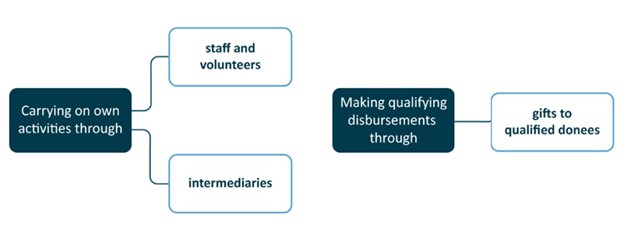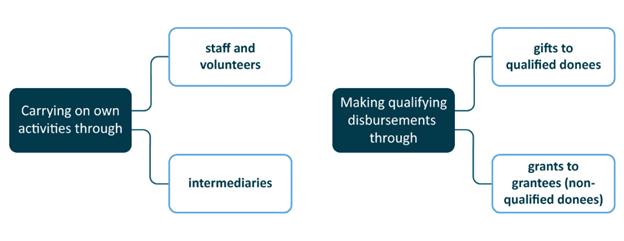
When it comes to soliciting donations from foundations or other charities, the requirements are usually pretty stringent.
In the U.S., it’s virtually impossible to apply for a foundation grant without nonprofit 501(c)(3) status. In Canada, the rules have traditionally excluded any organization that is not a registered charity or qualified donee from applying.
However, changes are afoot in Canada that may open up grant opportunities to a wider range of organizations. So if you are a smaller Canadian nonprofit organization without one of the aforementioned designations, you may be in luck.
Terminology
Before we get into these changes, let’s disentangle some of the vocabulary you will need to know. If you are already familiar with the following terms, skip ahead to the next section.
Qualified Donees
According to the Canada Revenue Agency (CRA), “Under the Income Tax Act, qualified donees are organizations that can issue official donation receipts for gifts they receive from individuals and corporations. Registered charities can also make gifts to them.”
Within Canada, qualified donees include registered charities as well as registered Canadian amateur athletic associations, journalism organizations, housing corporations, Canadian municipalities, and municipal or public government bodies.
Registered Charities
You may have noticed from the definition above that a registered charity is one type of qualified donee, so there is some overlap in the terminology.
As defined by the CRA, “Registered charities are charitable organizations, public foundations, or private foundations that are created and resident in Canada.” So not only are registered charities a subset of qualified donees (and eligible to receive charitable donations and grants), but to make things even more confusing, a registered charity can also be a grant-giving foundation.
The missions of registered charities fall into four possible categories: poverty relief, education, religion, and other purposes that benefit the community.
Nonprofit Organizations
Nonprofit organizations are distinct from registered charities, and are defined as “associations, clubs, or societies that are not charities and are organized and operated exclusively for social welfare, civic improvement, pleasure, recreation, or any other purpose except profit.” The main difference between the two is that registered charities must only operate for charitable purposes, whereas nonprofit organizations can encompass a range of other purposes besides profit.
Recent Changes to the Tax Code
Registered charities in Canada are allowed to use their resources in two ways. First, a registered charity can use its funds to carry out its own activities, either through its own organization (staff and volunteers) or through another organization that performs an activity for the registered charity, also known as an intermediary. This has not changed. The second way a registered charity can use its resources is by making qualified disbursements, referred to as either gifts or grants by the CRA.
Prior to 2022, Canadian registered charities were only allowed to disburse funds to qualified donees, which as you will remember, include registered charities and other specific types of organizations.
Before 2022

(This image is an edited version of an image found on the CRA’s Guidance document.)
In 2022, the Income Tax Act was amended to allow Canadian registered charities to also make disbursements to non-qualified donees (grantees), both within Canada and abroad. Non-qualified donees are defined by the CRA as “organizations in Canada and internationally [that] contribute to charitable activities, but do not have registered charity status with the Canada Revenue Agency (CRA).” Following this change, questions abounded as to how this would be carried out in practice.
Since 2022

(This image is taken from the CRA guidance document.)
Guidance For Charities Awarding Grants to Non-Qualified Donees
In order to offer some clarity on the issue, at the end of 2022, the CRA released draft guidance on the topic and solicited feedback. In December 2023, the CRA released the final version of the Guidance titled Registered charities making grants to non-qualified donees.
The new Guidance states, “When a charity intends to collaborate with another organization, it should consider at the outset whether it will do this through a grant to a grantee, a gift to a qualified donee, or by carrying on its own activities through an intermediary. The decision rests with the charity.”
A registered charity may award a grant to a non-qualified donee if a) the grant is used for a charitable purpose, b) the grant is used for a charitable activity that furthers the specific charitable purpose of the grantmaking charity, and c) the grantmaking charity maintains sufficient documentation.
If a charity decides to carry out its own activities through an intermediary, it may do so by maintaining “direction and control” of the work that a non-qualified donee performs. If the charity decides to award a grant to a non-qualified donee, either in the form of cash or non-cash resources, the charity must meet certain accountability requirements. The Guidance attempts to outline these requirements.
Who May Benefit From the Changes
What types of non-qualified donees (grantees) are most likely to get funded under the revised Guidance? In short, those that are considered low risk.
One of the key aspects of the Guidance is that it puts the onus on the registered charity to perform a risk assessment and due diligence when considering whether to award a grant to a non-qualified donee. It outlines different criteria to perform a risk assessment and determine whether an organization is high-, medium-, or low-risk.
Among other factors, low-risk organizations are defined as those that have a great deal of experience with grants or working with non-qualified donees (such as an intermediary), have a clear governance structure, are located in Canada or another stable country or region, and have a mission that is closely aligned with that of the charity. High-risk organizations are basically the opposite—they are newly established, have no experience working with grants or with non-qualified donees, have limited or no organizational structure, and are located outside Canada in an unstable region with a lack of infrastructure, or in a country where the organization has no experience.
So we can extrapolate from this that non-qualified donees located in Canada or other developed countries will have a greater likelihood of securing grants, as will organizations that are older in age with significant experience.
Organizations that are considered high risk may have a smaller chance of securing a grant and be subject to heightened oversight if they do receive one, such as site visits, formal written grant agreements, and interim and final reports.
Grant amounts and the type of support awarded also play a key role in determining risk. Low-risk grants range in value up to $5,000, whereas medium- and high-risk grants range from $5,000 to $50,000 and over $50,000, respectively. In addition, donations of non-cash resources, such as medical supplies, are considered a much lower risk than donations of cash, property, or cryptocurrency.
Thus, grant applicants who are non-qualified donees should seek grants in lower amounts (ideally under $5,000) or in the form of an in-kind donation if they would like to increase their chances of securing support under the new rules.
Reactions to the New Guidance
The Guidance document released in December 2023 has already been subject to scrutiny.
Some have argued that it places an undue burden on charities. The law firm Torkin Manes stated that the Guidance “imposes significant challenges on charities wishing to make grants to non-qualified donees, most notably with the requirements for assessing the risks of making a grant.”
Along similar lines, the company KPMG noted that the factors charities must consider when evaluating a potential grant to a non-qualified donee were not ranked in terms of importance. “So, all charities, even the smallest will now have to analyse all risks, such as social, economic and political as well as the reputation and capabilities of the particular grantee, and the size and length of the grant, to decide if it is high, medium or low risk and then take appropriate measures.”
Others have raised concerns about legal ambiguity when it comes to interpreting the new guidelines. Authors on the Canadian Charity Law blog stated, “Generally, we would suggest that most Canadian registered charities not use the new grant to grantee system except in exceptional cases . . . ” Until there is further clarification by the CRA or court cases to help in interpreting the law, they suggest that it may be better for charities to support a non-qualified donee via an intermediary organization, or the “direction and control rules,” as there is more legal precedent in that area. In addition, KPMG pointed out that the consequences for failing to assure that a grant is used appropriately are not outlined in the Guidance.
On the other side of the spectrum were organizations that expressed a more favorable response. Philanthropic Foundations Canada lauded the new guidelines as a “historic evolution in charitable regulation in Canada,” further stating that they “provide flexible and principles-based pathways for genuine partnerships between foundations and NQDs, without being overly prescriptive.”
Adoption of the New Rules
Given the trepidation felt by many about the new Guidance, it is likely that foundations and other charities will hold off on the decision of whether to open their grants to non-qualified donees. In the end, they may decide that, at this point in time, it is not worth the legal risk or the added due diligence. Here at GrantStation, in our work in the Canadian Charitable database, we haven’t noticed a big uptick in funders changing their eligibility requirements just yet. As the final draft of the Guidance was only recently released, it may take some time to see how this actually plays out. In the meantime, non-qualified donees will be watching closely.
- Read the Canada Revenue Agency’s final Guidance, Registered charities making grants to non-qualified donees.
- If you are a GrantStation Member that uses the Canadian Charitable database, keep an eye on changes in the eligibility field of funder profiles over the next year to see if foundations you are interested in have updated their eligibility guidelines.